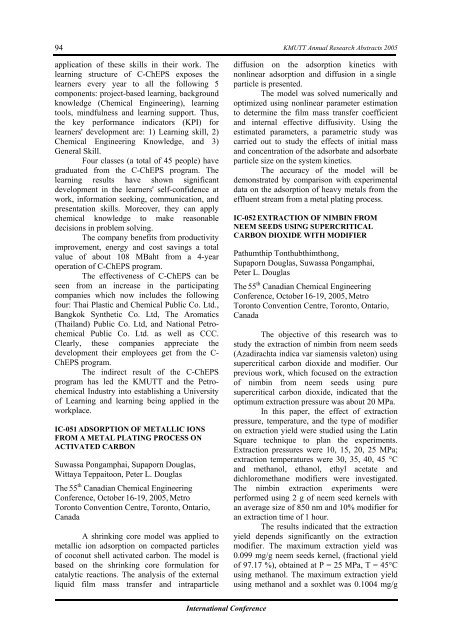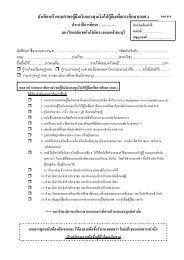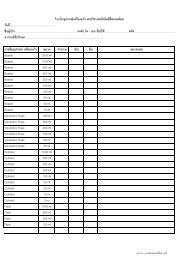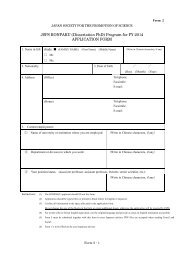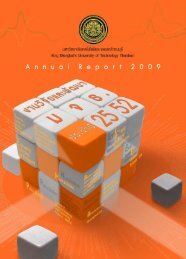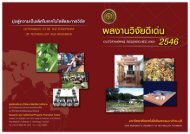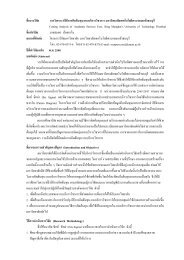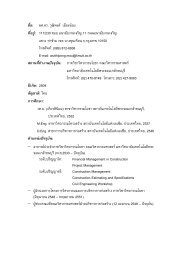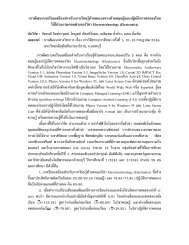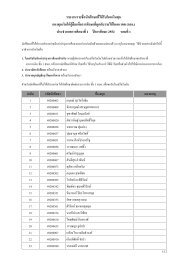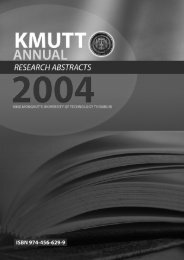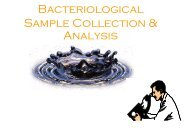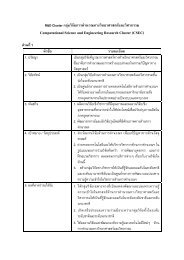You also want an ePaper? Increase the reach of your titles
YUMPU automatically turns print PDFs into web optimized ePapers that Google loves.
94<br />
application of these skills in their work. The<br />
learning structure of C-ChEPS exposes the<br />
learners every year to all the following 5<br />
components: project-based learning, background<br />
knowledge (Chemical Engineering), learning<br />
tools, mindfulness and learning support. Thus,<br />
the key performance indicators (KPI) for<br />
learners' development are: 1) Learning skill, 2)<br />
Chemical Engineering Knowledge, and 3)<br />
General Skill.<br />
Four classes (a total of 45 people) have<br />
graduated from the C-ChEPS program. The<br />
learning results have shown significant<br />
development in the learners' self-confidence at<br />
work, information seeking, communication, and<br />
presentation skills. Moreover, they can apply<br />
chemical knowledge to make reasonable<br />
decisions in problem solving.<br />
The company benefits from productivity<br />
improvement, energy and cost savings a total<br />
value of about 108 MBaht from a 4-year<br />
operation of C-ChEPS program.<br />
The effectiveness of C-ChEPS can be<br />
seen from an increase in the participating<br />
companies which now includes the following<br />
four: Thai Plastic and Chemical Public Co. Ltd.,<br />
Bangkok Synthetic Co. Ltd, The Aromatics<br />
(Thailand) Public Co. Ltd, and National Petrochemical<br />
Public Co. Ltd. as well as CCC.<br />
Clearly, these companies appreciate the<br />
development their employees get from the C-<br />
ChEPS program.<br />
The indirect result of the C-ChEPS<br />
program has led the KMUTT and the Petrochemical<br />
Industry into establishing a University<br />
of Learning and learning being applied in the<br />
workplace.<br />
IC-051 ADSORPTION OF METALLIC IONS<br />
FROM A METAL PLATING PROCESS ON<br />
ACTIVATED CARBON<br />
Suwassa Pongamphai, Supaporn Douglas,<br />
Wittaya Teppaitoon, Peter L. Douglas<br />
The 55 th Canadian Chemical Engineering<br />
Conference, October 16-19, 2005, Metro<br />
Toronto Convention Centre, Toronto, Ontario,<br />
Canada<br />
A shrinking core model was applied to<br />
metallic ion adsorption on compacted particles<br />
of coconut shell activated carbon. The model is<br />
based on the shrinking core formulation for<br />
catalytic reactions. The analysis of the external<br />
liquid film mass transfer and intraparticle<br />
KMUTT Annual Research Abstracts 2005<br />
diffusion on the adsorption kinetics with<br />
nonlinear adsorption and diffusion in a single<br />
particle is presented.<br />
The model was solved numerically and<br />
optimized using nonlinear parameter estimation<br />
to determine the film mass transfer coefficient<br />
and internal effective diffusivity. Using the<br />
estimated parameters, a parametric study was<br />
carried out to study the effects of initial mass<br />
and concentration of the adsorbate and adsorbate<br />
particle size on the system kinetics.<br />
The accuracy of the model will be<br />
demonstrated by comparison with experimental<br />
data on the adsorption of heavy metals from the<br />
effluent stream from a metal plating process.<br />
IC-052 EXTRACTION OF NIMBIN FROM<br />
NEEM SEEDS USING SUPERCRITICAL<br />
CARBON DIOXIDE WITH MODIFIER<br />
Pathumthip Tonthubthimthong,<br />
Supaporn Douglas, Suwassa Pongamphai,<br />
Peter L. Douglas<br />
The 55 th Canadian Chemical Engineering<br />
Conference, October 16-19, 2005, Metro<br />
Toronto Convention Centre, Toronto, Ontario,<br />
Canada<br />
The objective of this research was to<br />
study the extraction of nimbin from neem seeds<br />
(Azadirachta indica var siamensis valeton) using<br />
supercritical carbon dioxide and modifier. Our<br />
previous work, which focused on the extraction<br />
of nimbin from neem seeds using pure<br />
supercritical carbon dioxide, indicated that the<br />
optimum extraction pressure was about 20 MPa.<br />
In this paper, the effect of extraction<br />
pressure, temperature, and the type of modifier<br />
on extraction yield were studied using the Latin<br />
Square technique to plan the experiments.<br />
Extraction pressures were 10, 15, 20, 25 MPa;<br />
extraction temperatures were 30, 35, 40, 45 °C<br />
and methanol, ethanol, ethyl acetate and<br />
dichloromethane modifiers were investigated.<br />
The nimbin extraction experiments were<br />
performed using 2 g of neem seed kernels with<br />
an average size of 850 nm and 10% modifier for<br />
an extraction time of 1 hour.<br />
The results indicated that the extraction<br />
yield depends significantly on the extraction<br />
modifier. The maximum extraction yield was<br />
0.099 mg/g neem seeds kernel, (fractional yield<br />
of 97.17 %), obtained at P = 25 MPa, T = 45°C<br />
using methanol. The maximum extraction yield<br />
using methanol and a soxhlet was 0.1004 mg/g<br />
International Conference


